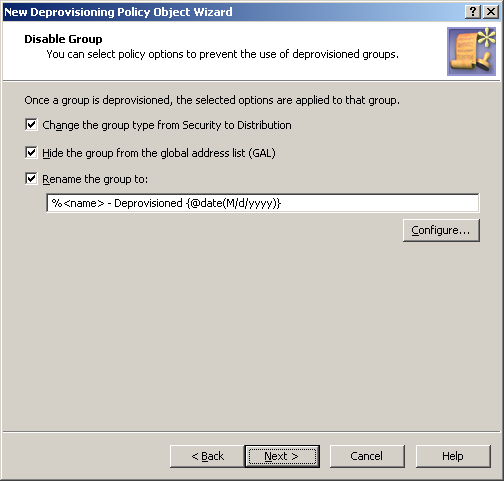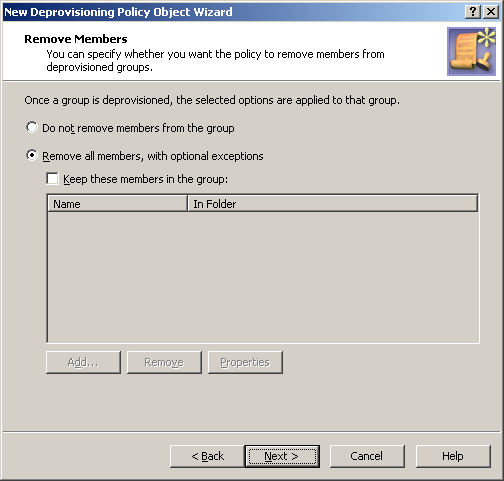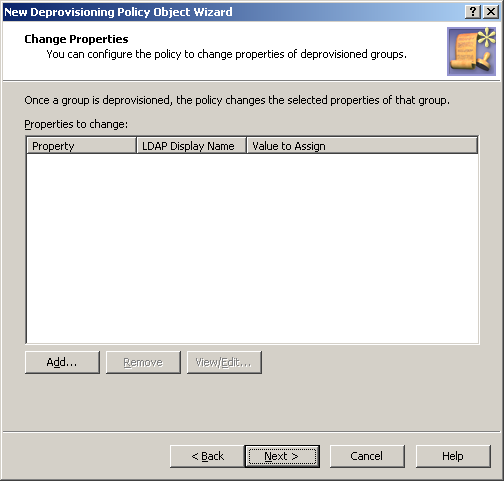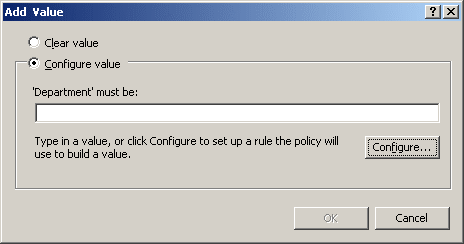To configure a Group Object Deprovisioning policy, select Group Object Deprovisioning on the Policy to Configure page in the New Deprovisioning Policy Object wizard or in the Add Deprovisioning Policy wizard. Then, click Next to display the Disable Group page.
Figure 95: Disable Group

On this page, you can choose from the following options:
- Change the group type from Security to Distribution. Revokes access rights from deprovisioned groups. This option is applicable only to security groups.
- Hide the group from the Global Address List (GAL). Prevents access to deprovisioned groups from Exchange Server client applications. This option is applicable to distribution groups or mail-enabled security groups.
- Rename the group to. Changes the name of the group.
Select the check box next to each option you want the policy to apply.
By selecting the Rename the group to check box, you direct the policy to change the name of the group. This option allows you to configure a property update rule that specifies how to modify the group name. Click the Configure button and follow the instructions provided in the Configuring a property update rule section, earlier in this chapter.
Once you have completed the Disable Group page, click Next to display the Remove Members page.
Figure 96: Remove members

On this page, you can configure a rule on how to remove members from deprovisioned groups.
Select one of these options:
- Click Do not remove members from the group if you want the policy not to remove members from deprovisioned groups.
- Click Remove all members, with optional exceptions if you want the policy to remove members from deprovisioned groups.
With the second option, you can specify whether you want the policy not to remove certain objects from deprovisioned groups. To set up a list of such objects, select the Keep these objects in the group check box, and then click the Add button and select the objects you want to include in the list.
Once you have completed the Remove Members page, click Next to display the Change Properties page.
Figure 97: Change Properties

On this page, you can set up a list of group properties you want the policy to update. Each entry in the list includes the following information:
- Property. When deprovisioning a group, Active Roles will update this property of the group object in Active Directory.
- LDAP Display Name. Uniquely identifies the property to be updated.
- Value to Assign. After the deprovisioning operation is completed, the property has the value defined by the rule specified.
You can use these buttons to manage the list on this page:
- Add. Allows you to select a property and configure an update rule for that property. A property update rule specifies how to generate the new value to assign to the property.
- Remove. If you want the policy to no longer update a given property, select the property from the list and click Remove.
- View/Edit. Allows you to modify the update rule for the property you select from the list.
Clicking the Add button displays the Select Object Property dialog box where you can choose group properties you want to the policy to update. To choose a property, select the check box next to the property name, and then click OK.
You can select multiple check boxes. If you do so, the properties you have selected are added to the list on the wizard page, with the update rule configured to clear those properties, that is, to assign them the empty value.
If you select a single property in the Select Object Property dialog box, you are presented with the Add Value dialog box so you can proceed to configuring a property update rule.
Figure 98: Add value

You can select one of these update options:
- Clear value. Causes the policy to assign the “empty” value to the property.
- Configure value. Allows you to configure a value for the ‘property’ must be condition.
With the second option, you must configure a value the policy will assign to the property upon the group deprovisioning. You can configure a value in the same way as you do when configuring a property update rule for the user name: Click the Configure button and follow the instructions provided in the Configuring a property update rule section, earlier in this chapter.
When you are done configuring a value, click OK to close the Add Value dialog box. The property name along with the property update rule is added to the wizard page. If necessary, you can modify the update rule by clicking the View/Edit button beneath the list of properties. This displays a dialog box, similar to the Add Value dialog box, allowing you to choose a different update option or set up a different value for the ‘property’ must be condition.
Once you have set up the list on the wizard page, click Next and follow the instructions in the wizard to create the Policy Object.
